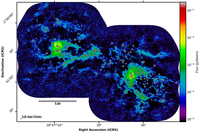Science Highlight
The ALMA-IMF Large Program aims to answer the longstanding question on whether the Initial Mass Function (IMF) inherits its shape from its core content, and more precisely the Core Mass Function (CMF). To do that, ALMA-IMF has targeted and imaged 15 high-mass star-forming regions in the nearby Milky Way (d ≤ 6 kpc). In a recently accepted paper (Pouteau et al.,2022), the team has used high-resolution, ~ 0.5 arcsec, Band 6 (1.3 mm) and Band 3 (3 mm) data to detect and extract ~200 peaked cloud structures of few thousand AU, called cores, in the W43-MM2&MM3 protocluster cloud (see figure). The authors find that, unlike what was found for several decades, the CMF of this cloud - qualified as mini-starburst - is top-heavy, i.e. it has an excess of high-mass cores compared to low and intermediate cores. In detail, the slope of the high-mass end α=-0.95 ± 0.05 cannot be represented by the canonical slope of the IMF, α=-1.35 followed by the CMF of low-mass star-forming regions. Moreover, fragmentation scenarios applied to the observed CMF predict a top-heavy IMF, that could be a signature of starburst events. The authors conclude that the IMFs emerging from starburst events could inherit their shape from their parental CMFs and remain top-heavy, thus questioning the IMF universality.

